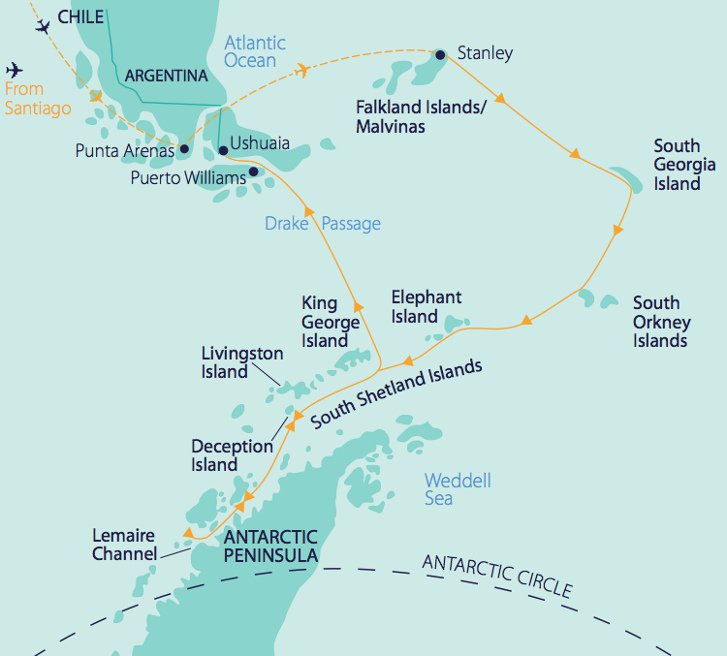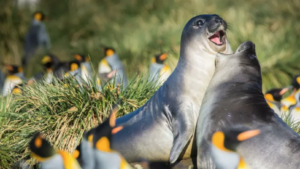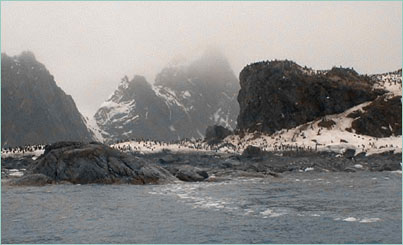In-Depth South Georgia and Antarctica Fly/Cruise
Itinerary Map

Summer comes to South Georgia’s remote, untamed landscape like a freight train. Famed for its abandoned whaling stations and Shackleton’s heroic journey, South Georgia is home to millions of fur seals and penguins, wallows of elephant seals, and nesting albatross. We arrive at the breeding cycle peak, as chicks become juveniles, parents shuttle fish and seal pups thrill with mock charges. Retracing Shackleton’s boat voyage, we visit Elephant Island before continuing south along the Antarctic Peninsula. Days remain long, and filled with humpback and minke whales, penguins and leopard seals, historic sites and scientific stations
Voyage Highlights
South Georgia
- Witness the incredible wildlife of South Georgia, one of the greatest wildlife concentrations on the planet
- Visit some of the world’s largest king penguin rookeries and search for wandering albatross on nests
- See beaches thick with elephant and fur seals
- Cruise past Elephant Island’s dramatic north coast (weather permitting)
- Trace the final leg of Sir Ernest Shackleton’s perilous journey from Fortuna Bay to Stromness
- Pay your respects to the great explorer at a visit to his gravesite at Grytviken
Antarctica
- Explore the most accessible and wildlife-rich region of Antarctica
- Daily shore visits and Zodiac cruises offer close encounters with penguins, whales, seals and sea birds
- Visit historic research huts and working scientific stations
- Cruise past massive icebergs and ancient glaciers
- Enjoy the pristine beauty and vast landscapes
- Witness the endless sunlight of the midnight sun
- Learn about Antarctica’s unique geology, history and wildlife from our expert team
- Kayakers will glide through narrow sheltered waterways and fjords, paddle amongst ice floes and drift quietly alongside wildlife

Length of Travel: 18 Days
Itinerary in Brief
- Day 1: Flight from Santiago (or Punta Arenas), Chile to Stanley, Falkland Islands
- Days 2-3: At Sea bound for South Georgia
- Days 4-8: South Georgia
- Days 9-10: At Sea
- Day 11: Elephant Island
- Days 12-15: Antarctic Peninsula
- Days 16-17: Drake Passage
- Day 18: Ushuaia, Argentina
Detailed Itinerary
Day 1: Flight from Santiago (or Punta Arenas), Chile to Stanley, Falkland Islands

You will make your own way to the airport to embark your flight in Santiago (or Punta Arenas) and arrive in Stanley in the early afternoon where you will be met by a local guide at the Mount Pleasant airport and transferred directly to Polar Pioneer. The expedition staff and our competent Russian crew will welcome you aboard Polar Pioneer in the afternoon.
Sailing towards South Georgia, we settle into shipboard life and enjoy our first meal on board.
Days 2-3: At Sea bound for South Georgia
Between the Falklands and South Georgia you will be entranced by the ceaseless flight of the many seabirds that follow our wake. You may decide to join the whale watchers on the bridge, or just relax and read a favorite book.
If time and weather conditions permit, we could pass close to Shag Rocks, a fascinating group of jagged rocky islets protruding from the sea. Blue-eyed cormorants fill the air; their precarious nesting sites are white with guano.
The mood on board is definitely casual. A favorite pastime is to stand at the stern deck watching the many seabirds, including majestic albatrosses and giant petrels, following in our wake, skillfully using the air currents created by the ship to gain momentum. Feeling transformed, we approach South Georgia, receptive and open.
Days 4-8: South Georgia

To us, South Georgia is one of the most beautiful places in the world. The island is a tiny speck in the South Atlantic Ocean, located in one of the most desolate parts of our planet. A 10,000 ft (3,000 m) mountain range traces the spine of this long, narrow island. Between the mountains, shattered glaciers carve their way through tussock grass to the deeply indented coastline.
Though geographically speaking, the island lies in the subantarctic area, as do the islands of Macquarie and Heard, it has a climate more in keeping with the true Antarctic regions. This is because South Georgia lies wholly within the Antarctic Convergence.
South Georgia is a British possession, having been claimed and named for King George III on January 16th 1775 by Captain James Cook, who records in his journal:
“The wild rocks raised their lofty summits till they were lost in the clouds and the valleys lay buried in ever-lasting snow. Not a tree or a shrub was to be seen, no, not even big enough to make a toothpick. I landed in three different places, displayed our colors and took possession of the country in His Majesty’s name under a discharge of small arms.” —”Antarctic Housewife” by Nan Brown.
On May 20th 1916, Sir Ernest Shackleton, Crean and Worsley stumbled into the busy whaling station at Stromness; hungry, exhausted and covered in grime. They had just made the first ever crossing of the mountains of South Georgia, from King Haakon Bay, to find help for their three exhausted companions left at Cave Cove and rescue the men they had left on Elephant Island. They had sailed in the James Caird for 16 days under horrendous conditions and found safety in the tiny entrance of Cave Cove. This epic story of survival had begun with the sinking of his ship, the Endurance, in the Weddell Sea, six months earlier.
As we explore South Georgia, we will have the opportunity to reflect on Shackleton’s epic journey.
Some other glorious destinations we plan to visit in South Georgia are:
Grytviken
Originally a Norwegian sealing and whaling station, it was finally abandoned in 1965. Here we must be careful to avoid stepping on sleeping elephant seals as we skirt the ruins of factory buildings peering into the past, trying to imagine what it was like when whale processing was in full swing. Abandoned ships lie sunken alongside old wharves, while pitted concrete walls remind us of the more recent Falkland’s War, which started here.
Sir Ernest Shackleton died from a heart attack during his final expedition on board the Quest on May 6th 1922. His body was laid to rest at Grytviken and we hope to make a pilgrimage to visit the cross his men erected in his memory looking out across beautiful Cumberland Bay.
St Andrews Bay
The sandy, black beach is a resting place for hundreds of elephant seals that haul out on the shore to molt. Behind the beach, the sight and sound of tens upon tens of thousands of king penguins at different stages of their breeding cycle will be overwhelming. The glacial river that runs into the sea here will be alive with penguin chicks and elephant seal pups testing their aquatic skills. If we lift our gaze from the wildlife for a moment, we will glimpse the snow-capped peaks of some of the world’s most spectacular mountains.
Godthul
Imagine indented bays lined with bleached whalebones, teeming with fur seals and with penguins just “hanging about”. Here you have the opportunity to clamber through the tussock to a spectacular plateau offering magnificent views across the island and the waters beyond. A careful descent leads us to a magnificent Macaroni penguin rookery.
Prion Island
We will aim to visit Prion Island where we can sit quietly to watch serene wandering albatrosses sitting proudly on eggs or cute downy chicks. We may be blessed by the performance of an intimate courtship dance, or may witness a youngster being lovingly fed. We watch adolescents exercising their wide wing spans, trying to launch themselves into the air, as they realize that mom and dad will no longer feed them and they must leave the island in search of food.
Other stunning wildlife destinations we may visit include: Elsehul Bay; Royal Harbor; Cooper Bay; Drygalski Fjord; Larsen Harbour; Stromness; Salisbury Plains; Gold Harbor; Right Whale Bay; Possession Bay.
Days 9-10: At Sea
Leaving South Georgia we head across the Scotia Sea in a south-westerly direction.
The ocean takes on a whole new perspective once we are surrounded by the surreal presence of floating ice sculptures. The memory of the sight of your first iceberg will remain with you forever.
Day 11: Elephant Island

Today, if weather permits, we set course for Elephant Island, a half-submerged mountain cloaked with an ice sheet at the outer limits of the South Shetlands. En route, our recaps and lectures will resume and there will be time to gather energy for the busy days ahead.
We’ll learn the story of Shackleton and hear how his ship, the Endurance, was crushed in pack ice in the Weddell Sea, before he and his men climbed into three open boats, spending 16 months at sea, before finally making landfall on this tiny toe of rock and ice in the vastness of the Southern Ocean on April 14th 1916.
As we commemorate the centenary of Shackleton’s fateful expedition, we plan to sail past Cape Valentine to see the beach where the men first put ashore nearly 100 years ago. Weather permitting; we hope to follow the coastline six miles west to Point Wild, where the men eventually set up camp under two of their upturned open boats and some old tents.
We will attempt to make at least one landing on historic Elephant Island.
Days 12-15: Antarctic Peninsula

Once we arrive in the calmer waters of the Bransfield and Gerlache Straits, we will generally make landings or Zodiac excursions two to three times a day.
Days will be spent cruising along spectacular ice cliffs, following whales that are feeding near the surface, and landing on the continent and it’s off-shore islands to visit penguin rookies and seal haul outs as well as a few of our favorite spots on the peninsula.
Our chefs will prepare delicious meals that, accompanied by good conversation, will become a focal point of our shipboard life.
There are many exciting places we can choose to visit. A sample of these is:
Half Moon Island
A wildlife rich island tucked into a neat bay at the eastern end of Livingston Island. On a clear day the glaciers and mountains of Livingston Island dominate the scene. There is a large chinstrap penguin rookery tucked in between basaltic turrets colored by yellow and orange lichens. Gulls nest on these turrets and there are often fur seals and elephant seals hauled out on the pebble beaches. At one extremity of the island there is a large colony of nesting blue-eyed shags. At the other end lies a small Argentine station that is sometimes occupied by scientists conducting research on the penguin colony and surrounding waterways.
Paradise Harbor
A protected bay surrounded by magnificent peaks and spectacular glaciers, the rocky cliffs of this unforgettable piece of heaven provide perfect nesting sites for blue-eyed shags, terns and gulls. The serenity of Paradise Harbor envelops us once the sound of the dropping anchor fades from our ears. This is a haven for whales and we keep our eyes open for humpbacks, orcas and minkes, as well as crabeater seals, as we explore the bay in Zodiacs. Imagine being so close to a whale that when he surfaces to blow, the fishy spray of his exhalation momentarily blurs your vision. Words cannot describe this experience.
Other places we may visit around the Antarctic Peninsula are: Pleneau Island; Neko Harbor; Vernadsky, a Ukrainian scientific base; Port Lockroy, a historic British base that is now a museum and post office; plus a selection of our other favorite landing sites.
Days 16-17: Drake Passage

Time to head to Ushuaia, Argentina, with lectures and videos to complete our Antarctic education. This is a time for reflection and discussion about what we have seen and felt, and the impact this voyage has had on our attitude to life. As we approach the tip of South America, our Captain may sail close to legendary Cape Horn, weather conditions permitting.
Day 18: Ushuaia, Argentina

During the early morning we cruise up the Beagle Channel, before quietly slipping into dock in Ushuaia, where we disembark. It’s a busy time, saying farewell to our crew and to fellow passengers who have shared the intensity of exploring this magnificent white wilderness. We head off in our different directions, hopefully with a newfound sense of the immense power of nature.


